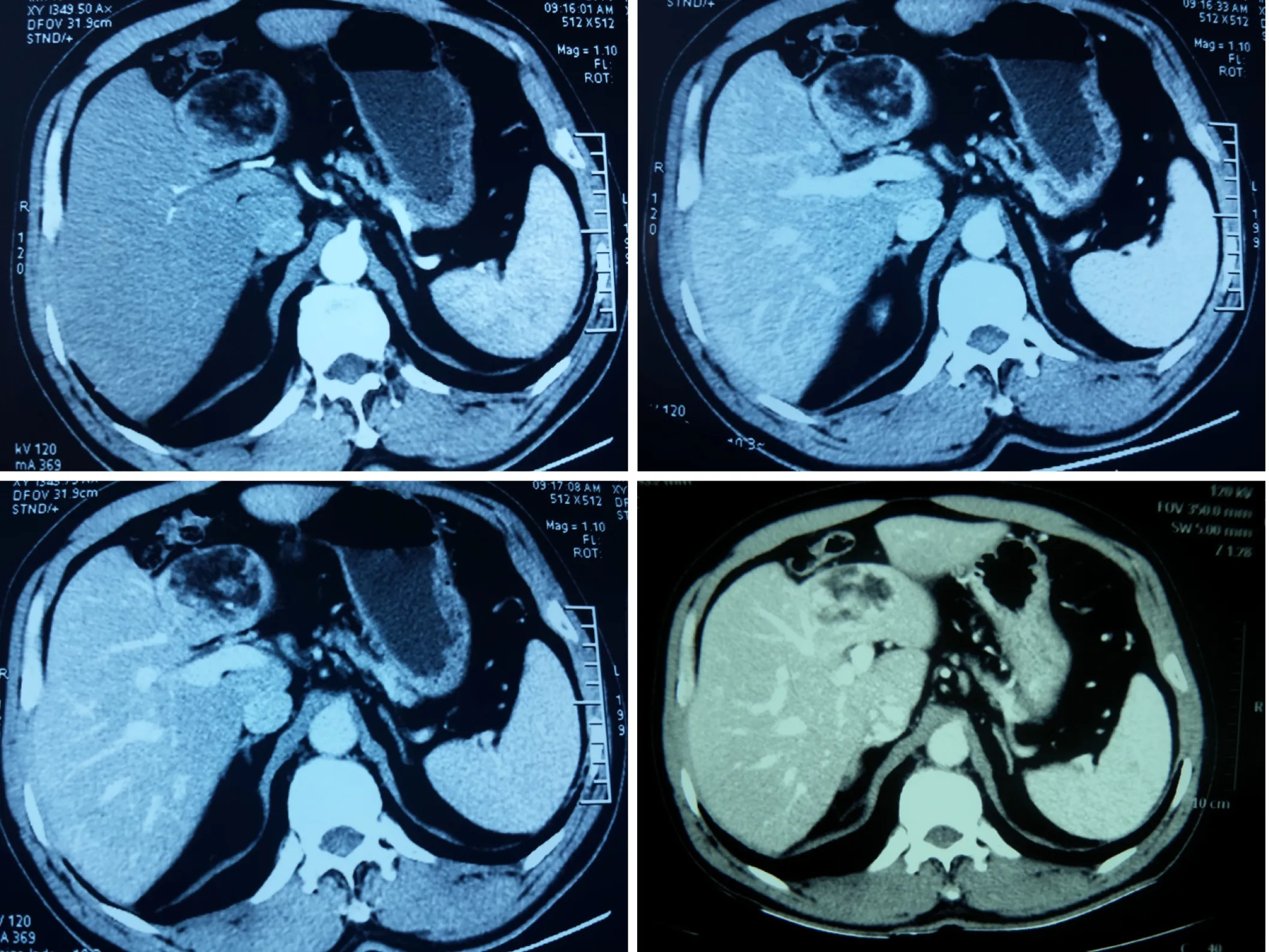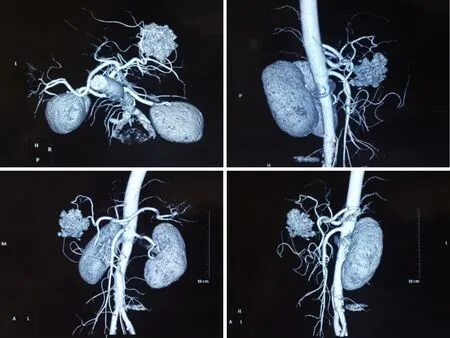Primary hepatic myelolipoma:A case report and review of the literature
Ke-Yu Li,Ai-Lin Wei,Ang Li
Ke-Yu Li,Ai-Lin Wei,Ang Li,Department of Hepato-Bilio-Pancreatic Surgery,West China Hospital,Sichuan University,Chengdu 610041,Sichuan Province,China
Abstract BACKGROUND Primary hepatic myelolipoma is a rare hepatic mesenchymal tumor mixed by adipose tissue and bone marrow,and there is a lack of general guidelines related to its epidemiology and clinical management.CASE SUMMARY A 26-year-old woman was admitted to our department complaining of a newly found tumor on her left lobe of the liver.The tumor was painless and not associated with any systemic or localized compressive symptoms.Serological tests disclosed a slight increase of gamma-glutamyl transpeptidase(70.0 U/L)and total bilirubin(19.2 μmol/L).Ultrasonography showed a mass about 5.0 cm × 5.0 cm in size that was located in the left lobe of the liver and displayed hyperechoic and well-encapsulated characteristics.Surgical resection was applied,and the following histopathological examination observed a variable proportion of myeloid tissues scattering throughout mature fibrotic adipose tissues,in which myeloid,erythroid,and megakaryocytic cells can be found in magnified view.The follow-up did not show any changes 6 mo after surgery.CONCLUSION This case highlights an extremely rare hepatic mesenchymal tumor,the primary hepatic myelolipoma,and discloses the common characteristics behind this disease and gives clinical recommendations.
Key Words:Hepatic myelolipoma;Liver neoplasms;Myelolipoma;Tumor;Liver;Extraadrenal myelolipoma;Case report
INTRODUCTION
Myelolipomas are a kind of benign tumor first reported by Gierke[1]as early as 1905 and named by Oberling[2]24 years later.Myelolipomas are mesenchymal tumors composed of adipose tissue and bone marrow-derived hemopoietic elements like myeloid,erythroid,and megakaryocytic cells.The majority of myelolipomas occur in the adrenal glands,but cases with extra-adrenal myelolipomas(EAMs)have also been reported in the presacral region,retroperitoneum,mesentery,etc.In general,EAMs are asymptomatic,but in some circumstances,they can produce severe complications including local compressive effects,rupture,and hemorrhage if not treated properly.Primary hepatic myelolipoma was first named in France in 1973[3].We present herein a case of primary hepatic myelolipoma and consider the rarity of this benign hepatic tumor.We also collected the clinical data of almost all the primary hepatic myelolipoma(HM)cases that have been reported and compared them with our case in this paper.
CASE PRESENTATION
Chief complaints
A 26-year-old woman with a newly found tumor on the left lobe of her liver was admitted to our department.
History of present illness
The tumor was found in a medical examination 3 d ago without any pain or any systemic or localized compressive symptoms.
History of past illness
The patient had a free previous medical history.
Physical examination
When admitted,the patient’s temperature was 36.5 °C,heart rate was 81 bpm,respiratory rate was 16 breaths per minute,blood pressure was 121/70 mmHg,and oxygen saturation in room air was 99%.No abnormal signs were detected.
Laboratory examinations
Serological tests disclosed a slight increase of gamma-glutamyl transpeptidase(70.0 U/L)and total bilirubin(19.2 μmol/L).
Imaging examinations
Ultrasonography showed a hyperechoic and well-encapsulated mass roughly 5.0 cm ×5.0 cm in size located in the left lobe of the liver.Computed tomography(CT)scans disclosed a quasi-circular mass measuring about 5.0 cm × 6.0 cm × 5.0 cm on the segment 4 of the liver,with mixed density.Under the contrast-enhanced CT scan,the density of this oval mass was mixed,with the edge and some parts intensified.Detailedly,as shown in Figure 1,in the early arterial phase,the tumor was not well intensified,while in the subsequent portal phase,the boundary of the whole tumor and some parts in the center get well-intensified,which lasted to the final phase.The last figure in Figure 1 shows a higher layer of the tumor that presented typical central enhancement.CT angiography revealed a mass in the liver with a rich blood supply that did not correlate to the main branches of the hepatic arteries(Figure 2).

Figure 1 Computed tomography images of hepatic myelolipoma.A quasi-circular mass with mixed density was presented via a computed tomography scan.The mass was about 5.0 cm × 6.0 cm × 5.0 cm in size,located on the left lobe of the liver.In the image from a contrast-enhanced computed tomography scan,an oval mass of mixed density was detected,with the edge and some parts intensified.
FINAL DIAGNOSIS
The final diagnosis of the presented case was primary hepatic myelolipoma.
TREATMENT
Considering the imaging characteristics of the tumor,we suspected this tumor to be benign and planned to perform a needle biopsy;however,after discussing with the patient,she asked for a full resection.A laparoscopic non-anatomic hepatectomy was performed to fully remove the tumor,and the resected tumor was transferred to our pathology department for further histopathological examination.The hepatic myelolipoma was made up of some yellow adipose tissue with clear blood vessels through the laparoscopic view.Histologically,most of the mass consisted of irregularly fibrotic adipose tissue,in which conspicuous islands of myeloid elements,including myeloid,erythroid,and megakaryocytic cells,were scattered(Figure 3).
OUTCOME AND FOLLOW-UP
Follow-up by CT scans and ultrasonography did not show any changes 6 mo after surgery.

Figure 2 Imaging of hepatic myelolipoma by computed tomography angiography.Angiography imaging presented a mass in the liver with a rich blood supply that did not correlate to the main branches of the hepatic arteries.
DISCUSSION
Literature review
We present an asymptomatic HM and review another 24 previously published cases to include in our analysis,in which we summarize the clinicopathological information including patients’ age,gender,clinical symptoms,tumor location,tumor size,imaging findings,liver functions,diagnostic methods,and treatments in Table 1[3-26].According to our analysis,primary HM occurred in females more than males,with an incidence of 64.0% and 36.0%,respectively.The mean age at presentation was 54(54.4± 12.32)years.Six patients were asymptomatic,and patients who presented with clinical manifestations had minimal symptoms.Based on the analysis of tumor sizes and locations,we found that primary HM often occurred within the right lobe(16/25),and over half of the patients had tumors less than 10 cm in diameter,with the largest reaching 17 cm.Imaging modalities including ultrasound,CT scans,or magnetic resonance imaging(MRI)scans were used to locate these masses and hepatic angiography was utilized to help determine their blood supply.Serologically,liver enzymes ranged from normal to slightly elevated.Moreover,almost all patients received invasive interventions like a needle biopsy or an operation followed by pathological examinations to confirm their diagnosis.
Epidemiology and etiology
EAMs are extremely rare benign tumors composed of mature adipose tissue and hematopoietic elements.Most EAMs are unintentionally discovered during surgery or autopsy,and manifest as a single lesion with a diameter ranging from 4 cm to 15 cm.EAMs are more common in people over 60 years old[27].Due to the macroscopic adipose tissue within an adrenal myelolipoma,a preoperative diagnosis is relatively easy to makeviaa CT or MRI scan.However,it is difficult to diagnose an EAM based on imaging because of its variable location and other clinical characteristics.EAMs have been reported to occur in the retroperitoneum,presacral tissue,perirenal tissue,lung,and nasal cavity,but hepatic EAMs are extremely uncommon[28-31].
Although several hypotheses have been proposed as to the cause of myelolipoma,the etiology and exact pathogenesis are still unknown.Possible causes include the degeneration of adrenal tumors or adenomas,metaplasia of the early adrenal cortex mesenchymal stem cells,and translocation of differentiated bone marrow tissueduring embryogenesis[32].At present,a widely accepted theory is metaplasia of the reticuloendothelial cells of blood capillaries.However,Bishopet al[33]demonstrated a pattern of X-chromosome inactivation in the hematopoietic elements and fat of myelolipomas,indicating that the majority of these masses were clonal proliferation derived from a pluripotential stem cell[33].The etiology of HM is also not fully understood but may be related to the translocation of adrenal glands or the metaplasia of hepatic cells.Furthermore,based on the data of the tumor sites that we collected,we boldly speculate that the most likely reason for HM to grow more in the right lobe is because of the close anatomic relationship to the right adrenal gland.However,further studies are needed to more thoroughly and accurately explain this phenomenon.

Figure 3 Visual and pathological view of hepatic myelolipoma.The quasi-circular mass on the right hepatic lobe consisted of some yellow adipose tissue with clear blood vessels through the laparoscopic view.Under a microscope,a variable proportion of myeloid tissues scattered throughout irregularly mature fibrotic adipose tissues(hematoxylin-eosin staining,20 × 10),in which myeloid,erythroid,and megakaryocytic cells can be found in magnified view(hematoxylin-eosin staining,50 × 10).
Diagnosis
To diagnose primary HM before a pathological examination is difficult.Patients are usually asymptomatic or manifest mild symptoms like right upper quadrant discomfort,pain,and liver enlargement.Serological tests can be normal or show slight changes on some non-specific enzymes,like alkaline phosphatase,glutamic pyruvic transaminase,and gamma-glutamyl transpeptidase.Imaging can be helpful in diagnosing these tumors.Ultrasonography is able to show hyperechoic lumps with a clear boundary.CT scans may present quasi-circular,sometimes lobulated,masses with clear borders,partially or fully enveloped by membranes that were confirmed to be pseudocapsules aggregated by connective tissue under pathological examinations.These masses consist of variable low-density adipose tissue(-78-20 Hounsfield units)and medium density bone marrow tissue,and sometimes even present with enhancement on contrast-enhanced CT due to the calcification,infarction,or hemorrhage[34].MRI scans can detect hyperintense signals from fat tissue on the T1-weighted sequences while T2-weighted sequences may detect intermediate to hyperintense signals due to the different concentrations of myeloid components[35].For myelolipomas with a suspicion of malignancy,an 18-flurodeoxyglucose-PET scan is capable of tracking the malignant components by exposing increased uptake[36].
Pathology
At present,although fat suppression imaging techniques contribute to the diagnosis,a needle biopsy followed by pathological examination remains the primary method to confirm the diagnosis.In our case,the primary HM was composed of irregularly mature fibrotic adipose tissue and some myeloid tissue with myeloid,erythroid,and megakaryocytic cells inside.Moreover,although both adrenal and extra-adrenal myelolipomas containing bone spicules have been reported,HM cases with reticular sinusoids or heterotopic ossification have never been shown[37].The main differential diagnosis of a primary HM includes well-differentiated liposarcoma,hepatic angiomyolipomas,hepatic hamartoma,echinococcosis,extramedullary myeloid cell tumor,etc.
Treatment
Due to the rare incidence,no general surgical guidelines are mentioned in the studied literature and most surgical excisions were performed because of the mass effect or the uncertainty regarding the nature of the tumor.For asymptomatic ECMs with a small size,if malignancy can be ruled out,the recommended clinical management is observation,according to the American Association of Clinical Endocrinologists/American Association of Endocrine Surgeons Guideline(2009).We believe that this kind of clinical management for some HMs is acceptable;however,surgical intervention is warranted for those HMs with the larger size,because they may manifest symptoms due to a mass effect and increase the possibilities of spontaneous rupture or acute abdomen.Intralesional hemorrhage,infarctions,and suspicion of malignancy are also indications for surgery[38].It is worth mentioning a case reporting the synchronous occurrence of a hepatic myelolipoma and two hepatocellular carcinomas in one patient[25].Therefore,we have to emphasize that for those patients in whom malignancy cannot be ruled out,a preoperative biopsy is recommended[13].Fortunately,the prognosis of primary HM is relatively good following appropriate resection and postoperative follow-up is not needed.Moreover,it is worth mentioning that,depending on the location of primary HMs,a laparoscopic hepatectomy,interventional radiology,or embolization can also be utilized to achieve a better prognosis.In the present case,we recommended needle biopsy instead of surgery at first,but the patient herself insisted on a full removal of this neoplasm from her body no matter benign or malignant.Our clinic team finally designed a laparoscopic nonanatomic hepatectomy to remove the tumor and keep the maximum volume of segment 4.
CONCLUSION
In summary,only a few cases of primary hepatic myelolipoma have been reported,and by reviewing all the 25 cases of primary HMs,we found that most of the patients were middle-aged women,asymptomatic,or with nonspecific clinical manifestations.The imaging characteristics of CT scans demonstrate low-density lesions localized in the right lobe with abundant blood supply and MRI scans demonstrate hyperintense signal on T1- and intermediate to hyperintense signal on T2-weighted sequences.Needle biopsy followed by observation is recommended,but resection should be considered if these masses meet surgical indications.
ACKNOWLEDGEMENTS
The authors appreciate the help of the pathologist for providing pathological data.
 World Journal of Clinical Cases2020年19期
World Journal of Clinical Cases2020年19期
- World Journal of Clinical Cases的其它文章
- Parathyroid adenoma combined with a rib tumor as the primary disease:A case report
- Displacement of peritoneal end of a shunt tube to pleural cavity:A case report
- Localized primary gastric amyloidosis:Three case reports
- Bochdalek hernia masquerading as severe acute pancreatitis during the third trimester of pregnancy:A case report
- Intravesically instilled gemcitabine-induced lung injury in a patient with invasive urothelial carcinoma:A case report
- Intraosseous venous malformation of the maxilla after enucleation of a hemophilic pseudotumor:A case report
